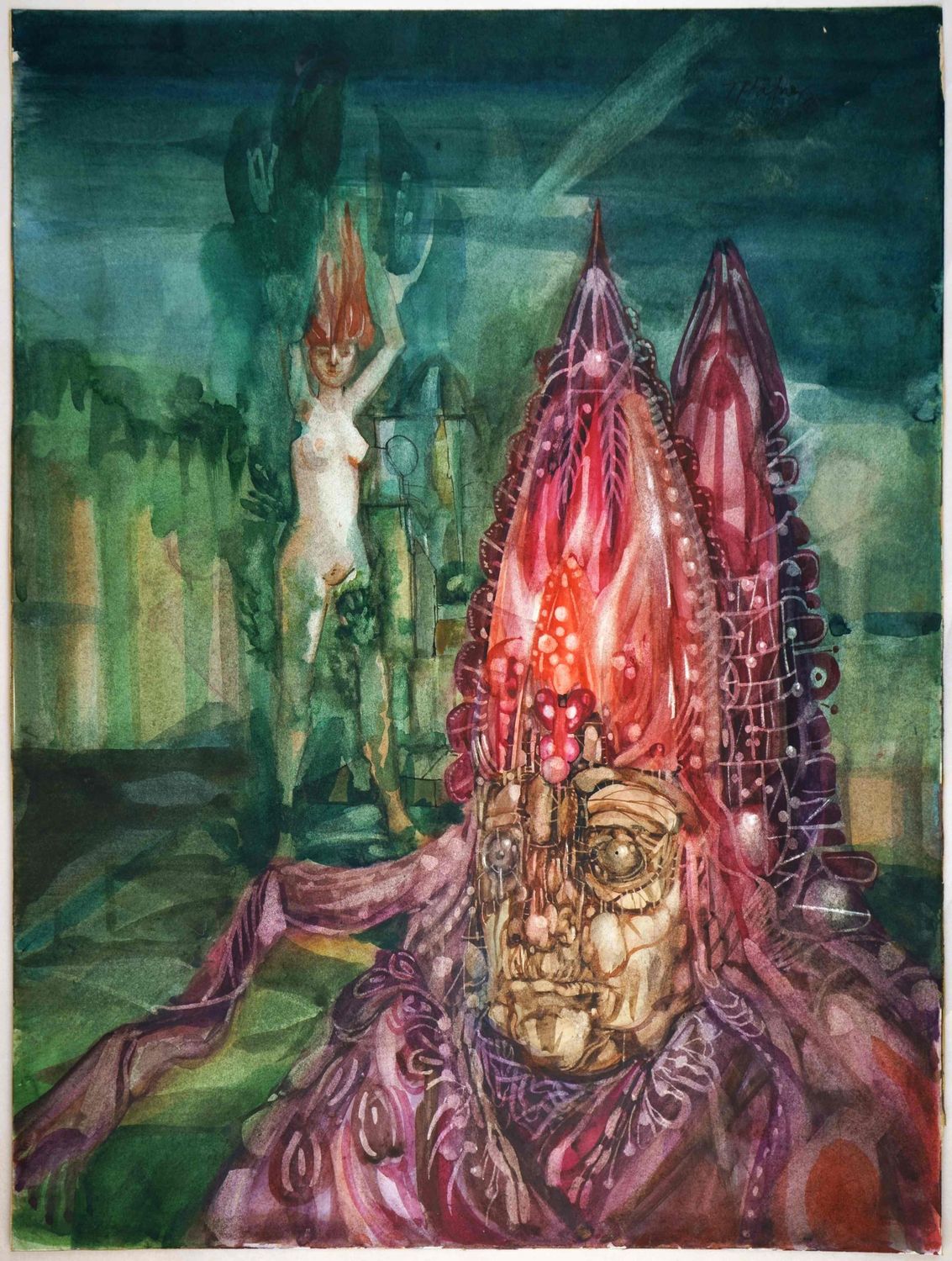Häfner, Thomas (1928-1985), The Vision of the Bishop, 1965
Thomas Häfner(1928 Berlin - 1985 Düsseldorf), The Vision of the Bishop , 1965. Watercolour on paper, 47.5 x 35.5 cm, signed and dated by hand at the upper right "T[homas]Häfner [19]65".
- good condition with strong colours, at the back side's margins remains of an old mounting
Exposé as
PDF
- Prisoner of his own desire -
A bishop is seen in the foreground of the picture, which seems to be a sculpture due to the bust-like cut. And indeed, his face has stony features. He is trapped 'forever' in this posture. And yet, a pendilion ribbon of the bishop's mitre blows, introducing a temporality into the picture that unfolds completely above the ribbon. There, a naked young beauty gazing at the bishop begins to change shape. Thomas Häfner has placed Daphne in the picture, who, according to Ovid's Metamorphoses, becomes a laurel tree in order to escape Apollo's persecution.
However, the transformation process does not only affect Daphne, but also the Bishop himself. Her metamorphosis, which dissolves her beauty, petrifies the bishop, who is enchanted by her. In an analogy to mythology, he, as Apollo, tries to grasp Daphne with the Pendilia ribbon, who is formally standing on the ribbon, but is nonetheless ungraspable and eludes him at the moment of her greatest presence and most provocative beauty.
If Apollo represents Eros, Daphne represents the coveted femininity par excellence. She is the unattainable "vision" of the bishop. That it is a vision is made clear by the fact that Daphne is behind the bishop's back and yet looks at him as if they were looking at each other, while the bishop's gaze is directed out of the picture, where he sees the unattainable beauty at a distance and yet very close. Also, the head with the miter is about the same height as Daphne's, to illustrate that she has emerged from his head. Both the Bishop and Daphne are of the same height, and yet the Bishop, subordinate to her, is entirely subject to his own vision. The church, barely visible between the bishop and Daphne, is completely absorbed in the grove of temptation.
One of Thomas Häfner's earliest paintings, from 1956, depicts the temptation of St. Anthony, a theme he takes up again here and reformulates in a sublimated form under psychoanalytical auspices: The bishop is his own tempter, from whom he cannot escape. He remains forever a prisoner of his own desires, which represent a "higher" reality than his faith, symbolized by the Church, which has almost completely disappeared. He is so captivated by the vision of his own desires as if his eyelids had been cut off, to use a phrase coined by Heinrich von Kleist in reference to Caspar David's Monk by the Sea . The bishop is unable to avert his almost vacant gaze and escape his vision. He is condemned to contemplate it forever as that which eludes him, clothed in the promise of his own desire: the purple episcopal vestments become, in the mitre, the fiery red of a femininely connoted organic ornament that seems to have consumed the bishop inwardly. This color crescendo of desire is accentuated by the green, so that the Bishop appears on this side of the painting, on our side, making it clear that he exemplifies only that which also defines us.
With this watercolor, which is also technically masterful, Thomas Häfner creates an image that, in its forcefulness, surpasses the works of Ernst Fuchs, whose fantastic realism is related to Häfner's art, but whose approach to the subject of Apollo and Daphne is far more conciliatory.
About the artist
Thomas Häfner was the son of the artist Herbert Häfner and the jewish painter Ilse Häfner-Mode. His mother was banned from exhibiting in 1933 and interned in the Elben concentration camp near Kassel in 1944. His father, who refused to agree to a divorce demanded by the Nazis, also suffered reprisals. In order to escape persecution, son Thomas was sent to Ceylon through the intermediary of Ilse Häfner-Mode's brother, Heinz Mode, later a professor of Oriental archaeology in Halle, where he lived from 1938 to 1948. Back in Germany, Thomas Häfner began his studies at the Düsseldorf Art Academy in 1949 and became a master student of Otto Pankok.
Thomas Häfner was one of the initiators of the Junge Realisten, a group founded in Düsseldorf in 1956 to oppose the hegemony of abstract painting. Other members were Hans-Günther Cremers, German Beccera, Hannelore Köhler, Wolfgang Lorenz, and Willi Wirth. From 1956 to 1966, group exhibitions were held in Düsseldorf, Berlin, Darmstadt, Vienna, Rouen, and Krefeld. Häfner presented the surreal works of his Fantastic Realism.
In 1975 he opened the jewelry gallery Sphinx in Düsseldorf and from then on devoted himself primarily to artistic jewelry design.
"Thomas Häfner, 'the painter of dreams', paints his pictures from the depths of the unconscious, as if in a dream. Without a preliminary sketch, he associatively and creatively assembles the scenes and leads them - even in their contrasts - to a synthesis".
- Ditmar Schmetz
Selected Bibliography
Freundeskreis Stadtmuseum Düsseldorf (Hrsg.): Thomas Häfner. Der Maler und Bildhauer. 1928-1985, Willich-Anrath 1995.
Ditmar Schmetz: Thomas Häfner (1928–1985) – Der Blick hinter die Maske. In: Ilse Häfner-Mode. Bilder im Lebens- und Liebesreigen, hrsg. v. Christian Walda, Rensburg 2013, S. 125-141.

